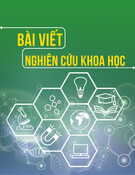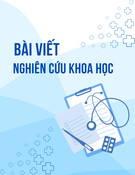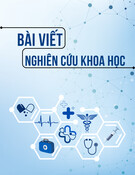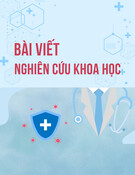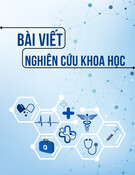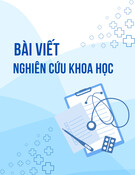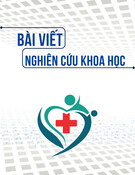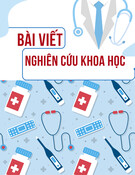
TẠP CHÍ Y häc viÖt nam tẬP 543 - th¸ng 10 - sè 1 - 2024
223
TÀI LIỆU THAM KHẢO
1. Anne Davin-Regli, et al., (2019), Enterobacter spp.:
Update on Taxonomy, Clinical Aspects, and
Emerging Antimicrobial Resistance. Cliniccal
Microbiology Reviews, Volume 32, September 2019.
2. Amy L. Leber, Clinical Microbiology Procedures
Handbook. 2016: ASM Press.
3. Clinical and Laboratory Standards Institute,
Performance Standards for Antimicrobial Susceptibility
Testing. 33rd ed. CLSI supplement M100 (2023).
4. Jari Intra, et al., (2023), Antimicrobial Resistance
Patterns of Enterobacter cloacae and Klebsiella
aerogenes Strains Isolated from Clinical
Specimens: A Twenty-Year Surveillance Study.
Antibiotics (Basel). 2023 Apr; 12(4): 775.
5. Malekzadegan, et al., (2017), Antimicrobial
Resistance Pattern and Frequency of Multiple-
Drug Resistant Enterobacter Spp. at A Tertiary
Care Hospital in Southwest of Iran. Journal of
Krishna Institute of Medical Sciences (JKIMSU),
2017, Vol 6, Issue 2, p33.
6. Phạm Thị Vân, và cs (2023), Tính kháng kháng
sinh của các chủn vi khuẩn Enterbacteriaceae
phân lập tại bệnh viện E (2018 – 2020). Truyền
nhiễm Việt Nam, Số 01 (41) 2023, tr 67 – 73.
7. Zeinab Mohseni Afsha, et al., (2021), The
Prevalence and Pattern of Enterobacter Antibiotic
Resistance in the Patients Admitted to Imam Reza
Hospital in Kermanshah, Iran (2016 - 2018).
Journal of Kermanshah University of Medical
Sciences, Vol. 25, Issue 1, Mar 2021.
8. Sang-Ho Choi, et al., (2008), Emergence of
Antibiotic Resistance during Therapy for
Infections Caused by Enterobacteriaceae
Producing AmpC β-Lactamase: Implications for
Antibiotic Use. Antimicrobial Agents and
Chemotherapy, Volume 52, Number 3, March 2008.
KHẢO SÁT TỈ LỆ SỬ DỤNG PHƯƠNG PHÁP XÔNG Y HỌC CỔ TRUYỀN
VÀ CÁC YẾU TỐ LIÊN QUAN Ở PHỤ NỮ SAU SINH TRONG THỜI KỲ
HẬU SẢN TẠI BỆNH VIỆN LÊ VĂN THỊNH, THÀNH PHỐ HỒ CHÍ MINH
Nguyễn Lê Việt Hùng*, Nguyễn Minh Thiện*, Nguyễn Thị Diểm Trinh*
TÓM TẮT55
Mục tiêu: Thời kỳ hậu sản là giai đoạn người mẹ
phải đối mặt với nhiều vấn đề sức khỏe nghiêm trọng
về thể chất lẫn tinh thần. Một số vấn đề thường gặp
như: nhiễm trùng hậu sản, chậm co hồi tử cung, đau
mỏi sau sinh làm ảnh hưởng đến sức khỏe người mẹ.
Phương pháp xông Y học cổ truyền được áp dụng từ
rất lâu tại các quốc gia Châu Á và Việt Nam, nhưng
chưa có số liệu thống kê đầy đủ. Nghiên cứu nhằm
khảo sát tỉ lệ sử dụng phương pháp xông YHCT sau
sinh và những yếu tố liên quan để làm cơ sở học tập,
ứng dụng, nghiên cứu khoa học. Đối tượng và
phương pháp nghiên cứu: Nghiên cứu cắt ngang –
mô tả thực hiện từ tháng 01/2024 đến tháng 05/2024
trên 380 phụ nữ sau sinh ≥ 18 tuổi, có con ≤ 6 tháng
tuổi đến khám tại bệnh viện Lê Văn Thịnh, đồng ý
tham gia nghiên cứu. Kết quả: Qua khảo sát 380
phụ nữ sau sinh, ghi nhận tỉ lệ sử dụng phương pháp
xông Y học cổ truyền trong thời kỳ hậu sản chiếm
62,37%, khai thác các thông tin đặc điểm nền về
nhóm tuồi, trình độ học vấn, nghề nghiệp, tình trạng
hôn nhân, điều kiện kinh tế, số con trong gia đình,
phương pháp sinh gần nhất, số lần khám thai, tình
trạng cho chon bú và người chăm sóc. Kết luận: Tỉ lệ
sử dụng phương pháp xông YHCT trong thời kỳ hậu
sản chiếm 62,37%. Các yếu tố liên quan ảnh hưởng
đến việc sử dụng xông YHCT sau sinh bao gồm tình
*Đại học Y Dược thành phố Hồ Chí Minh
Chịu trách nhiệm chính: Nguyễn Lê Việt Hùng
Email: viethung@ump.edu.vn
Ngày nhận bài: 5.7.2024
Ngày phản biện khoa học: 21.8.2024
Ngày duyệt bài: 16.9.2024
trạng hôn nhân và tình trạng kinh tế của người phụ nữ
sau sinh.
Từ khóa:
Xông Y học cổ truyền, phụ nữ sau sinh.
SUMMARY
SURVEY ON THE RATE OF USE OF
TRADITIONAL MEDICINE METHODS AND
RELATED FACTORS IN POST-BIRTH WOMEN
DURING THE POST-PARTIAL PERIOD AT LE
VAN THINH HOSPITAL, HO CHI MINH CITY
Objective: The postpartum period is a period
when the mother faces many serious physical and
mental health problems. Some common problems
such as: postpartum infection, slow uterine involution,
and postpartum pain affect the mother's health.
Traditional medicine steaming methods have been
applied for a long time in Asian countries and Vietnam,
but there are no complete statistics. The study aimed
to survey the rate of using traditional medicine
steaming methods after giving birth and related
factors to serve as a basis for learning, application,
and scientific research. Subjects and M ethods:
Cross-sectional - descriptive study conducted from
January 2024 to May 2024 on 380 postpartum women
≥ 18 years old, with children ≤ 6 months old who
visited Le Van Thinh hospital and agreed to participate
in the study. Results: Through a survey of 380
postpartum women, the rate of using traditional
medicine steaming methods during the postpartum
period was recorded at 62.37%, exploiting
background information about age group, education
level, occupation, marital status, economic conditions,
number of children in the family, most recent birth
method, number of prenatal check-ups, breastfeeding

























